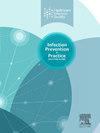Antibiotic resistance profiles in Gram-negative bacteria causing bloodstream and urinary tract infections in paediatric and adult patients in Ndola District, Zambia, 2020–2021
IF 1.8
Q3 INFECTIOUS DISEASES
引用次数: 0
Abstract
Background
Bloodstream infections (BSIs) and urinary tract infections (UTIs) caused by antibiotic resistant bacteria (ARB) have unfavourable treatment outcomes and negative economic impacts.
Objectives
The main objective of this study was to determine antibiotic resistance profiles in Gram-negative bacteria (GNB) causing BSIs and UTIs.
Method
A prospective study from October 2020 to January 2021 at Ndola Teaching Hospital and Arthur Davison Children's Hospital in the Ndola district, Zambia. Blood and urine samples collected from inpatients and outpatients presenting with fever and/or urinary tract infection symptoms were submitted for microbiological analysis. Pathogen identification and antibiotic susceptibility was determined by the automated VITEK 2 Compact machine. Resistance genes to commonly used antibiotics were determined using polymerase chain reaction. Data were analysed using SPSS version 28.0.
Results
One hundred and ten GNB were isolated, E. coli (45.5%) was predominant, with varying resistance profiles to different antibiotic classes. Resistance to third-generation cephalosporin was highest in Enterobacter cloacae (75%) and Klebsiella pneumoniae (71%), respectively. Emergence of carbapenem resistance was noted with the highest being 17% in Acinetobacter baumannii. Notably, the prevalence of multi-drug resistance was 63% and extensively drug-resistance was 32%. Resistance gene determinants identified included blaCTX-M, qnrA and blaNDM.
Conclusion
High level antibiotic resistance was observed in GNB known to be prevalent causative agents of BSIs and UTIs locally in Zambia. Improving microbiology diagnostic capacity, strengthening antimicrobial stewardship programs and enforcing infection prevention and control measures are of utmost importance in promoting rational use of antibiotics and preventing the spread and emergence of resistant pathogens.
2020-2021年赞比亚恩多拉区儿童和成人患者中引起血液和尿路感染的革兰氏阴性菌的抗生素耐药性概况
抗生素耐药菌(ARB)引起的血流感染(bsi)和尿路感染(uti)具有不利的治疗结果和负面的经济影响。目的本研究的主要目的是确定引起bsi和uti的革兰阴性菌(GNB)的抗生素耐药性。方法2020年10月至2021年1月在赞比亚恩多拉地区的恩多拉教学医院和亚瑟戴维森儿童医院进行前瞻性研究。收集有发热和/或尿路感染症状的住院和门诊患者的血液和尿液样本进行微生物学分析。采用全自动VITEK 2 Compact仪检测病原菌鉴定及药敏。采用聚合酶链反应测定常用抗生素耐药基因。数据分析采用SPSS 28.0。结果共分离GNB 110株,以大肠杆菌(45.5%)为主,对不同种类抗生素的耐药情况不同。第三代头孢菌素耐药率最高的分别是阴沟肠杆菌(75%)和肺炎克雷伯菌(71%)。鲍曼不动杆菌对碳青霉烯类耐药最高,达17%。值得注意的是,多药耐药率为63%,广泛耐药率为32%。抗性基因决定因素包括blaCTX-M、qnrA和blaNDM。结论GNB是赞比亚当地bsi和uti流行的病原体,对抗生素有高度耐药性。提高微生物学诊断能力,加强抗菌药物管理规划,加强感染预防和控制措施,对促进合理使用抗生素,防止耐药病原体的传播和出现至关重要。
本文章由计算机程序翻译,如有差异,请以英文原文为准。
求助全文
约1分钟内获得全文
求助全文
来源期刊

Infection Prevention in Practice
Medicine-Public Health, Environmental and Occupational Health
CiteScore
4.80
自引率
0.00%
发文量
58
审稿时长
61 days
 求助内容:
求助内容: 应助结果提醒方式:
应助结果提醒方式:


